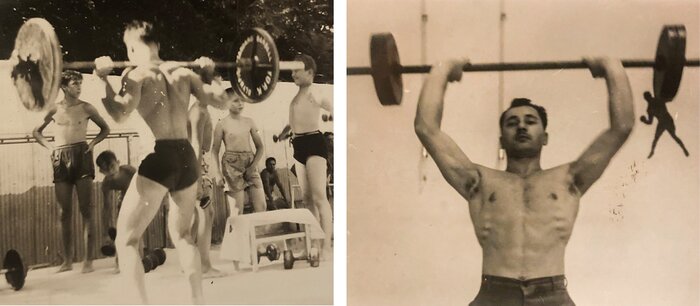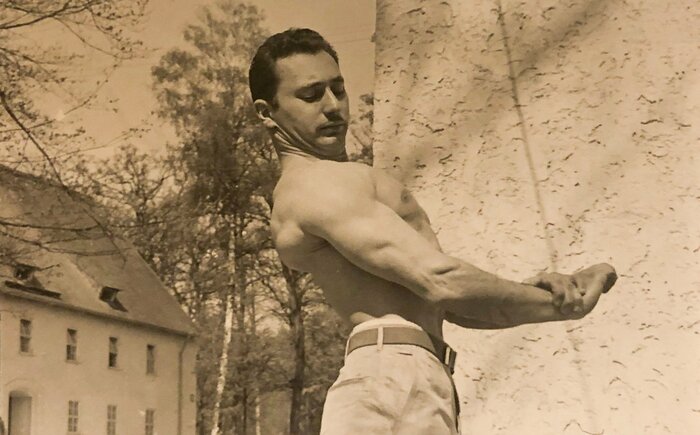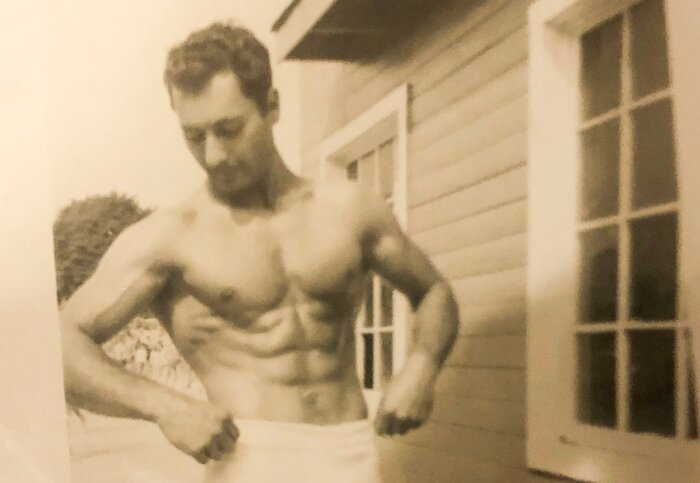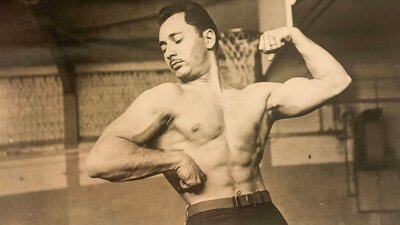My grandfather, Albert Fagan, passed away in April of 2020, at 93 years old, amidst the coronavirus pandemic. Up until his condition worsened for various reasons, he had been pain-free, mobile, and an extremely strong and independent individual for years.
And when I say "strong," I don't just mean strong for a man his age. At 90 years old, he had to undergo a minor medical procedure, where the doctor told my parents that my grandfather's arteries were the same as a 25-year-old's. The doctor then asked for my grandfather's secret, and he replied: strength training and healthy eating.
To the rest of us in the family, this was no secret at all. I'd seen him in the gym, at age 89, thoughtfully waiting out his rest period before cranking out a strenuous set of dumbbell rows. I'd heard him talk about the emotional high he still felt after a solid workout. I'd even seen him performing smooth pull-ups just a few months earlier.
My grandmother, Marian, always used to say the weights were her husband's first love. It was meant as a joke, but there was no question that my grandfather lived and breathed fitness.
How serious was he? He trained consistently for 79 years. Try to wrap your brain around that!
Although he's gone now, the example he set for me will live on. Here's what my grandfather the bodybuilder taught me:
1. Strength Training Is Life Training
"I started strength training when I was 13 years old," he told me when I interviewed him in 2017. "My uncle bought me cables for my bar mitzvah, and it was love at first sight. In 1945, at 17 years old, I went to a gym for the first time, and I noticed it made me feel great. I loved building up my body and strength. I became more and more confident, and I was always happy after I worked out because of the endorphins."
There was another reason that he wasn't as public about, though. My dad told me that my grandfather used to tell him that the main reason he started working out is because he was bullied for being Jewish. He wanted to get stronger to be able to stand up for himself.

From my perspective, growing up, I simply knew that Saba ("grandfather" in Hebrew) loved to lift weights, and that he ate very healthily. I remember going to my grandparents' house and looking at his Weider fitness magazines. He had piles upon piles of magazines, and they weren't considered weird or off-limits. To me, they became normal.
The Lesson: Over many years and many workouts, the reasons why you train can change and blend. But what doesn't change is that outer strength can shape your inner strength and how you view yourself. When you feel stronger and more confident, you can withstand life's challenges with greater resiliency.
2. There's More to Movement than Working Out
My grandfather loved hitting the gym and moving weights. But that wasn't the full extent of his training.
"Each morning, I perform a full-body movement routine which includes basic stretches and taking joints through their range of motion," he told me. "My favorites are deep knee bends (squats) and back arches (glute bridges)."
For him, this wasn't "working out." It was simple maintenance work that made him feel better instantly. It allowed him to maintain a supple body, healthy and strong joints, and start the day feeling energetic and capable.
The Lesson: It's easy for those of us in the fitness industry to focus on what's "optimal" for specific training goals in the gym. But don't forget that your body is made to move, first and foremost.
3. Train for the Long Run
Asking my grandfather how he trained was a big question. After all, over nearly eight decades, he'd done it all. But here's how he answered:
"I strength train 2-3 times a week for 2 hours each time. I warm up with the stationary bike and use light weights before my working sets. When I first started training, I used to do full-body workouts, and along the years, depending on my availability, I progressed to doing body-part-split workouts. I use a repetition range of 6-15 reps because I want to build muscle and avoid injuries. I was always in it for the long run."

Every day, I see people online defend and ridicule certain rep ranges and training styles like there are universal rights and wrongs in training. Saba's approach was so reasonable by comparison that it can sound quaint. But he found what worked for him, and he kept doing it.
The Lesson: Focus on enjoying the process and use every workout as an opportunity to safely improve and get stronger. But also don't forget about muscle, because as you get older, muscle matters.
4. Don't Undervalue How You Feel
High-level competitive bodybuilders often talk about training by "feel" or "intuition." My grandfather was no different. He told me that he let his gut guide him when it came to workout intensity. If he felt energized, he would push himself harder at the gym, whereas if he felt fatigued and tired, he would take it easy on himself—and not feel bad about it.
The Lesson: Don't get suckered in by the narrative of eternal improvement. Training intensity should ebb and flow. Listening to your body is one of the best things you can do to decrease risk of injury and promote a safe environment for growth and improvement over the long term.
5. Know Your Favorites
While my grandfather tried a little of everything over the years, he had a basic approach that he knew worked for him, and that he'd return to over and over again.
"I choose weight that I can lift for 10 reps, then add a little more weight and do 8 reps, and add a little more weight and do 6 reps," he told me.
Sometimes, he'd add a fourth set. Then, he'd use that approach for a few movements targeting whatever muscle groups he was training on that day and be done.

He also tried every movement in the book—or rather, in the magazines—over the years, but had a few favorites that he'd always return to. Some of these included:
Back:
Legs:
Shoulders:
Chest:
Triceps (his favorite muscle group to train):
- Triceps extension (variations)
Biceps:
Traps:
Abs:
The Lesson: Don't be afraid to learn, grow, and experiment. But also pay attention to what feels right, and what has worked for you in the past. Looking forward to a workout of your favorite moves, in your favorite style, is a great way to keep coming back over and over—which is really what pays off.
6. Eat Simply and Eat Well
To my knowledge, my grandfather never tracked his macros. But here's what he did instead: He ate until he was satisfied, but not stuffed. He always ate very slowly and took his time to enjoy and chew his food. He didn't deprive himself of foods he loved, like pizza and milkshakes, but knew how to eat them in moderation.
These occasional treats aside, his diet mostly consisted of whole, minimally processed foods. He ate fruits (bananas were his favorite), veggies, chicken, fish, eggs, whole-grain bread, peanut butter, and dark chocolate.
But he also knew that if the occasion arose where he wanted to tighten up and see what he'd been building, he had to clean up his nutrition to do it. Or as he put it, "Watch your diet if you want a six-pack."

The Lesson: His approach was a masterpiece of what we now often call "intuitive eating," encompassing all of the positive behaviors that nutritionists have come around to over the years. He showed me that this approach can be effective for weight management, health, and muscle and strength—without any deprivation.
7. Do It for Yourself, First and Foremost
"People have asked me along the years how come I never competed in bodybuilding competitions," he told me. "My reply was that I lift weights for my own fulfillment and gratification."
Would he have loved the challenge and competition of a prep? Maybe. But maybe not. And he knew that he didn't need the external validation. He just needed the ritual of training, and that was good enough for him.
The Lesson: Strength training is a highly personal journey with plenty of trial and error. It can take you in many different directions. But ultimately, it's all about investing in yourself and improving your life. Don't forget that.
8. You Never Have to Stop
There's a lot of fixation on achieving goals in fitness these days. And if that's your thing, great. But my grandfather's devotion to lifting wasn't about goals. It was seemingly about something bigger and more important.
For example, when I asked him about motivation to work out and if he ever thought about stopping lifting, he replied, "To me, it's like eating and sleeping."
He never won any pro cards, never got huge, never had followers. But he was a bodybuilder through and through, in the best possible way.
The Lesson: Sometimes, it's important think beyond goals. It's also OK to simply enjoy the ride.
A Simply Strong Life
My Saba wasn't groundbreaking in his approach. He was just following the example of the lifters who came before him and doing straightforward strength training. But his life is a great testimonial to what we all know we should be doing if we want to age gracefully and happily.
I hope reading this article and watching him articulate his philosophy has inspired you to invest in yourself and your health, or to continue doing it. Because if we're lucky, we've got a lot of years and many reps ahead of us.
Thank you, Saba, for being my biggest inspiration and fitness role model. You will be missed.



